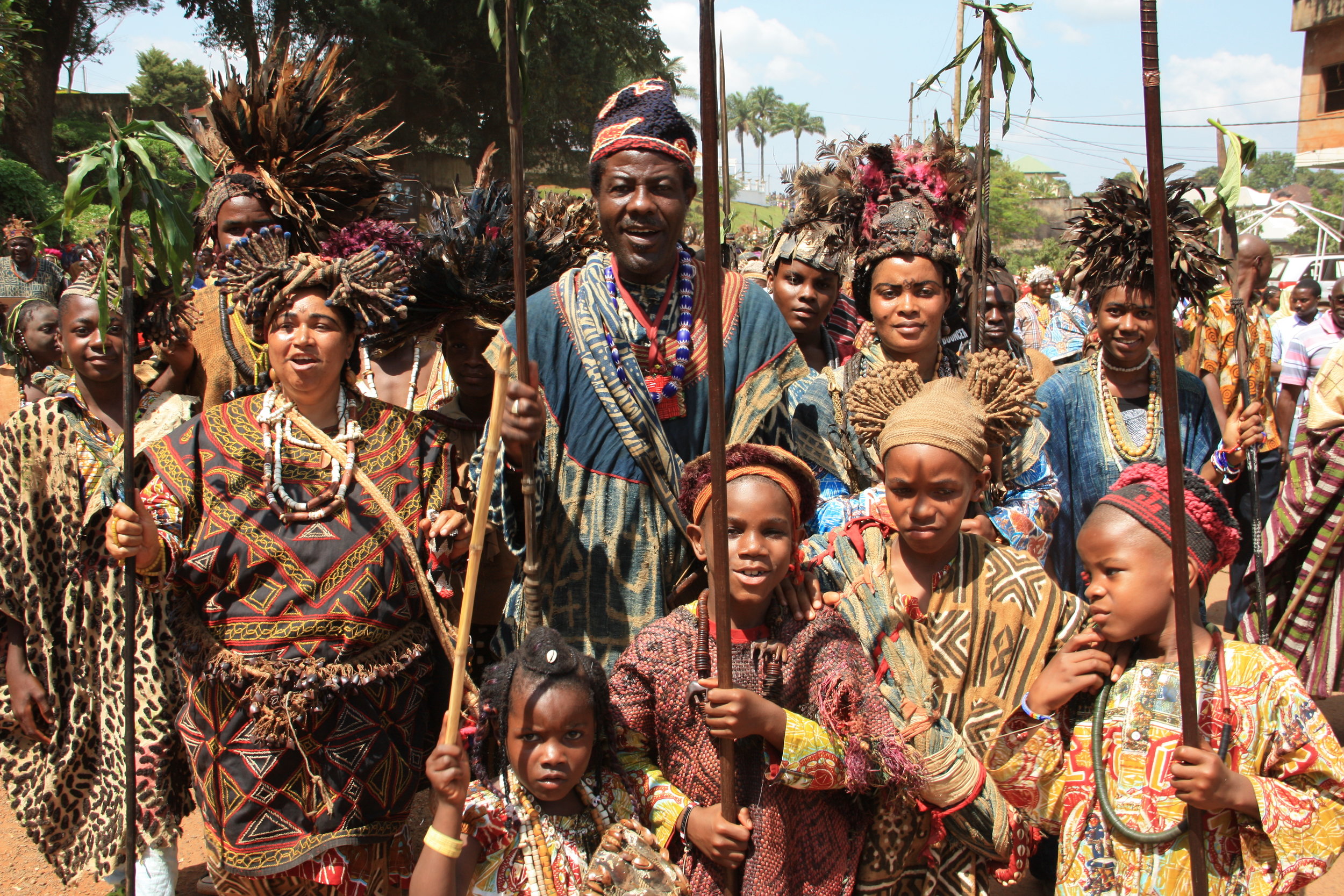Research
Below is the introduction to a draft of an article to be co-authored with Idrissou Njoya, professor of art and chef de département des arts décoratifs at the Institut des Beaux Arts de Foumban.
Visual Symbolism in the Nguon Parade
Since the late 1300s, Nguon has been many things to the Bamoun people of Cameroon: a grasshopper that appears in the fields around harvest time; the annual harvest festival named in honor of that insect; a men’s secret society dedicated to the well-being of the king and the kingdom; and a friction drum played only by members of that secret society for specific royal rituals.
Today, Nguon is a biennial ten day festival of Bamoun culture held in the departmental capital and home of the royal palace, Foumban, in November or December. Bamoun people from all over the Grasslands administrative department of Noun descend on the city, joined by their ex-pat compatriots and tourists from all over Cameroon, Europe, and North America. While there are commercial aspects of the modern incarnation of Nguon that are common to most festivals, there remain four events of historical and contemporary significance that represent the continuity of the dynamic mysteries at the heart of the Bamoun dynasty, which dates back to the late thirteenth century.
The first involves the ritual entrance into the darkened palace courtyard on Friday evening by members of the Nguon secret society, accompanying themselves on friction drums.[1] At midnight the king visits these councilors, seeking advice on his people’s grievances that will be presented to him in a monumental public ceremony the following day. The Nguon members remain in the palace grounds overnight, performing ritual music and dance.
The second event, held early Saturday morning in the main palace courtyard, is called sha’pam. During this public ritual, each of the chiefs of the Nguon present to the king a sack filled with a mixture of secret medicinal ingredients that ensures his continued success as ruler, and that of his kingdom.
Shortly following sha’pam, the king and his entourage process a few hundred meters to the larger nja courtyard near the main mosque. Here, dignitaries and invited guests from across Bamoun territory and the country gather to attend the third event, a ritual dethroning and judgment of the monarch. With spears of justice (kù mùtngu) thrust into the ground before him, the king rises from his ornate throne and stands, symbolically relegated to the status of common citizen, to hear the grievances of his people. In 2014, four spokesmen were chosen to give voice to a summary of the people’s concerns over the previous two years. This was followed by a sanctioning of the king for having neglected to discipline those of his royal entourage who abused their positions of privilege.[2] The event is brought to a close after a ritual sacrifice of a lamb and a speech, the Bamoun version of the state of the union, by the reinstated sultan.
The fourth Nguon event of historical and contemporary significance to the Bamoun people is the Sunday morning parade, held in two phases. The first begins with the pre-dawn beating of the nkindi drum, an enormous slit log drum carved from a massive tree trunk, signaling the king’s warriors to gather near the palace. They then process together to the city limits in the sho’melu ritual recalling the many battles fought and won under the rule of the great Bamoun warrior king of the late eighteenth and early nineteenth centuries, Mbouombouo.
The second phase of the Sunday parade, and the event that signals the end of Nguon for the majority of festival-goers, involves the triumphant return of the king to his palace, preceded by albino horses, accompanied by his victorious warriors, and surrounded by tens of thousands of Bamoun well-wishers. It is this celebratory march that is documented in this article.
In a carnivalesque atmosphere of warrior-inspired cultural pride, Bamouns display their sartorial prowess and aesthetic ingenuity through elaborate outfits incorporating animal, vegetable, and mineral elements. Warrior costumes abound, incorporating such gruesome features as animal skulls and horns atop hand-woven basket caps, full body paint, and crocodile skin shirts. Modern soldiers in khaki green mingle with ram’s-horn-clad sorcerers; spears, machetes, swords, axes, and bows ramble forward alongside decorated muskets and flintlocks. This is an all-ages affair, wherein whole families dress up and brave the hordes in joyous celebration of Bamoun-ness.
[1] The Brazilian cuica, sometimes called a lion’s roar, is one popular example of a small, hand-held friction drum.
[2] The exact form of the sanction was to be determined during a meeting with the nkom advisors in the aftermath of the festival. In 2012, the king was fined 10 large cows due to his lack of attention to protocol in an important ritual matter.
This is the introduction to a draft of an article to be co-authored with Idrissou Njoya, professor of art and chef de département des arts décoratifs at the Institut des Beaux Arts de Foumban.
END OF PREVIEW





